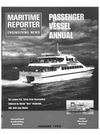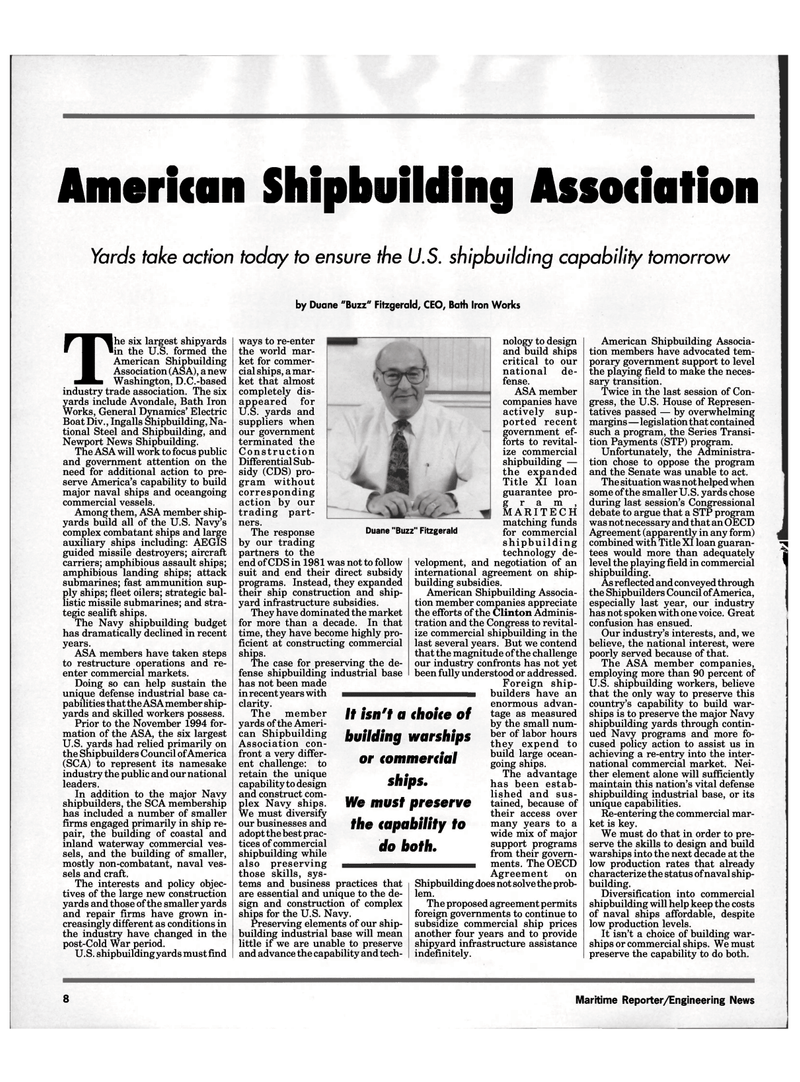
Page 6: of Maritime Reporter Magazine (January 6, 1995)
Read this page in Pdf, Flash or Html5 edition of January 6, 1995 Maritime Reporter Magazine
American Shipbuilding Association
Yards take action today to ensure the U.S. shipbuilding capability tomorrow by Duane "Buzz" Fitzgerald, CEO, Bath Iron Works
The six largest shipyards in the U.S. formed the American Shipbuilding Association (ASA), a new Washington, D.C.-based industry trade association. The six yards include Avondale, Bath Iron
Works, General Dynamics' Electric
Boat Div., Ingalls Shipbuilding, Na- tional Steel and Shipbuilding, and
Newport News Shipbuilding.
The ASA will work to focus public and government attention on the need for additional action to pre- serve America's capability to build major naval ships and oceangoing commercial vessels.
Among them, ASA member ship- yards build all of the U.S. Navy's complex combatant ships and large auxiliary ships including: AEGIS guided missile destroyers; aircraft carriers; amphibious assault ships; amphibious landing ships; attack submarines; fast ammunition sup- ply ships; fleet oilers; strategic bal- listic missile submarines; and stra- tegic sealift ships.
The Navy shipbuilding budget has dramatically declined in recent years.
ASA members have taken steps to restructure operations and re- enter commercial markets.
Doing so can help sustain the unique defense industrial base ca- pabilities that the ASA member ship- yards and skilled workers possess.
Prior to the November 1994 for- mation of the ASA, the six largest
U.S. yards had relied primarily on the Shipbuilders Council of America (SCA) to represent its namesake industry the public and our national leaders.
In addition to the major Navy shipbuilders, the SCA membership has included a number of smaller firms engaged primarily in ship re- pair, the building of coastal and inland waterway commercial ves- sels, and the building of smaller, mostly non-combatant, naval ves- sels and craft.
The interests and policy objec- tives of the large new construction yards and those of the smaller yards and repair firms have grown in- creasingly different as conditions in the industry have changed in the post-Cold War period.
U.S. shipbuilding yards must find ways to re-enter the world mar- ket for commer- cial ships, a mar- ket that almost completely dis- appeared for
U.S. yards and suppliers when our government terminated the
Construction
Differential Sub- sidy (CDS) pro- gram without corresponding action by our trading part- ners.
The response by our trading partners to the end of CDS in 1981 was not to follow suit and end their direct subsidy programs. Instead, they expanded their ship construction and ship- yard infrastructure subsidies.
They have dominated the market for more than a decade. In that time, they have become highly pro- ficient at constructing commercial ships.
The case for preserving the de- fense shipbuilding industrial base has not been made in recent years with ^hbihhi clarity.
The member yards of the Ameri- can Shipbuilding
Association con- front a very differ- ent challenge: to retain the unique capability to design and construct com- plex Navy ships.
We must diversify our businesses and adopt the best prac- tices of commercial shipbuilding while also preserving n^^^B^^m those skills, sys- tems and business practices that are essential and unique to the de- sign and construction of complex ships for the U.S. Navy.
Preserving elements of our ship- building industrial base will mean little if we are unable to preserve and advance the capability and tech-
Duane "Buzz" Fitzgerald nology to design and build ships critical to our national de- fense.
ASA member companies have actively sup- ported recent government ef- forts to revital- ize commercial shipbuilding — the expanded
Title XI loan guarantee pro- gram,
MARITECH matching funds for commercial shipbuilding technology de- negotiation of an ship-on
It isn't a We must preserve
the American Shipbuilding Associa-
tion member companies appreciate
the efforts of the Clinton Adminis-
tration and the Congress to revital-
ize commercial shipbuilding in the
last several years. But we contend
that the magnitude of the challenge
our industry confronts has not yet
been fully understood or addressed.
Foreign ship-
^^mm—m^m builders have an
enormous advan-
tage as measured
by the small num-
ber of labor hours
they expend to
build large ocean-
going ships.
The advantage
has been estab-
lished and sus-
tained, because of
their access over
many years to a
wide mix of major
support programs
from their govern-
_ ments. The OECD
Agreement on
Shipbuilding does not solve the prob-
lem.
The proposed agreement permits
foreign governments to continue to
subsidize commercial ship prices
another four years and to provide
shipyard infrastructure assistance
indefinitely.
American Shipbuilding Associa-
tion members have advocated tem-
porary government support to level
the playing field to make the neces-
sary transition.
Twice in the last session of Con-
gress, the U.S. House of Represen-
tatives passed — by overwhelming
margins—legislation that contained
such a program, the Series Transi-
tion Payments (STP) program.
Unfortunately, the Administra-
tion chose to oppose the program
and the Senate was unable to act.
The situation was not helped when
some of the smaller U.S. yards chose
during last session's Congressional
debate to argue that a STP program
was not necessary and that an OECD
Agreement (apparently in any form)
combined with Title XI loan guaran-
tees would more than adequately
level the playing field in commercial
shipbuilding.
As reflected and conveyed through
the Shipbuilders Council of America,
especially last year, our industry
has not spoken with one voice. Great
confusion has ensued.
Our industry's interests, and, we
believe, the national interest, were
poorly served because of that.
The ASA member companies,
employing more than 90 percent of
U.S. shipbuilding workers, believe
that the only way to preserve this
country's capability to build war-
ships is to preserve the major Navy
shipbuilding yards through contin-
ued Navy programs and more fo-
cused policy action to assist us in
achieving a re-entry into the inter-
national commercial market. Nei-
ther element alone will sufficiently
maintain this nation's vital defense
shipbuilding industrial base, or its
unique capabilities.
Re-entering the commercial mar-
ket is key.
We must do that in order to pre-
serve the skills to design and build
warships into the next decade at the
low production rates that already
characterize the status of naval ship-
building.
Diversification into commercial
shipbuilding will help keep the costs
of naval ships affordable, despite
low production levels.
It isn't a choice of building war-
ships or commercial ships. We must
preserve the capability to do both.
\
8 Maritime Reporter/Engineering News

 5
5

 7
7
